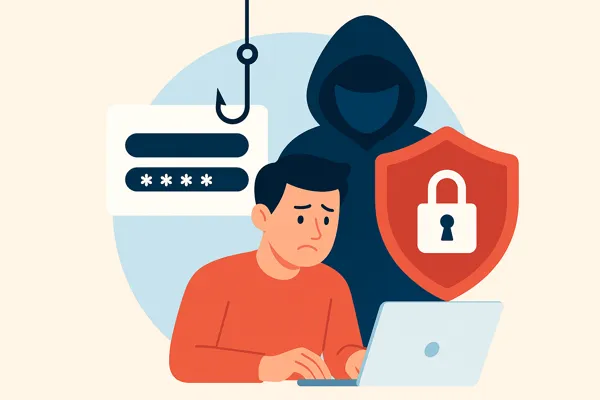Introduction to Credential Harvesting
Credential harvesting is a widespread cyberattack tactic where attackers aim to steal your login credentials, such as usernames, passwords, and email access information. These stolen credentials enable threat actors to gain unauthorized access to your accounts, exposing sensitive data and potentially leading to costly data breaches.
Hackers frequently employ techniques like phishing and social engineering to trick users into revealing their credentials. This poses a significant risk to both individuals and organizations. Understanding what credential harvesting is, how attackers execute these breaches, and the strategies to prevent such attacks is essential to securing your login information and protecting your digital identity from unauthorized access by malicious actors.
Cleanfox helps you eliminate spam and unwanted emails, so you can stay alert to what really matters.
By keeping your inbox free of clutter, you’re less likely to fall for phishing attempts—one of the most common methods used in credential harvesting attacks.
What is Credential Harvesting?
Methods of Information Capture
Credential harvesting refers to the practice of cybercriminals using various techniques to capture your login credentials, such as usernames and passwords, to gain unauthorized access to sensitive accounts and data. Common methods include phishing, where attackers send deceptive emails or messages that direct you to fake login pages designed to steal your information. Another widespread tactic involves deploying malware like keyloggers, which secretly record your keystrokes, including your login credentials.
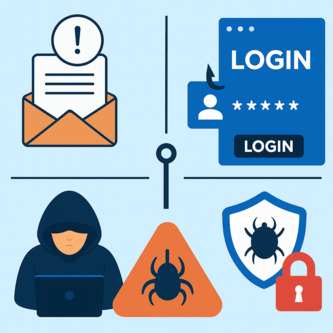
Cybercriminals may also use domain spoofing, creating fake websites that mimic legitimate ones to trick you into entering your details. In addition, Man-in-the-Middle (MitM) attacks intercept data transmissions, allowing attackers to capture credentials as you log in. More advanced strategies include credential stuffing, where previously harvested credentials from data breaches are reused to access multiple accounts, especially when users reuse passwords. Another tactic, password spraying, involves trying common passwords across numerous accounts to avoid triggering lockouts.
Industries at Higher Risk
Credential harvesting attacks are a significant threat across various sectors, particularly industries that handle large amounts of sensitive or financial data. Sectors like healthcare, finance, government, and technology are frequent targets due to the high value of the data and the potential for financial or operational disruption. Organizations within these industries often experience more sophisticated and frequent credential harvesting attacks.
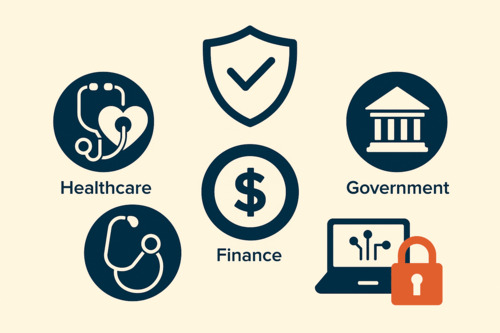
To counteract these threats, implementing secure credential management practices and robust multi-factor authentication (MFA) is essential. Without these measures, attackers exploit security gaps to access user accounts. This can lead to costly breaches and expose sensitive data like personal IDs and financial records.
How Hackers Execute Credential Harvesting
Phishing Emails and Fake Login Pages
Hackers often use phishing emails to harvest credentials. These messages pretend to come from trusted organizations or services. They lure victims into clicking links that lead to fake login pages made to look real. When you enter your login credentials on these fraudulent sites, attackers immediately capture your sensitive information.
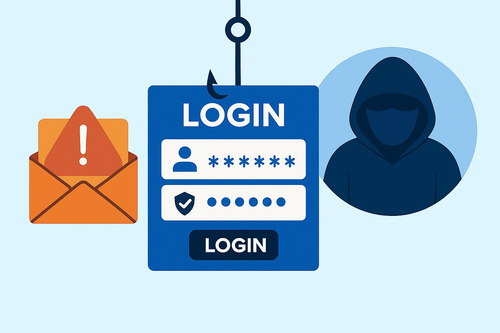
These phishing attacks rely heavily on social engineering tactics, exploiting your trust and urgency to act quickly. The attackers then use the stolen credentials to attempt unauthorized access across multiple accounts, a process sometimes automated in what’s known as credential stuffing.
Malware and Keyloggers
Another effective way hackers execute credential harvesting is through malware infections, including keyloggers and spyware. By embedding malicious software into your system—often delivered via infected email attachments or compromised websites—attackers can silently record every keystroke you make, capturing usernames, passwords, and other sensitive data without your knowledge. This method gives threat actors continuous access to your credentials and enables them to initiate further attacks, such as bypassing multi-factor authentication or exploiting the harvested data for subsequent breaches.
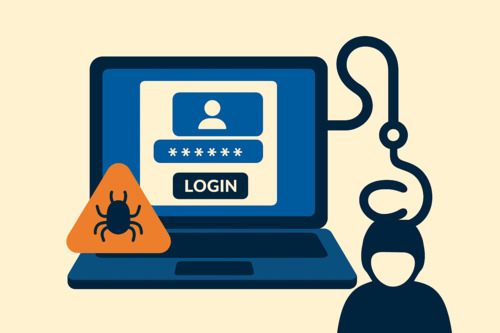
Malware-based harvesting is particularly dangerous because it operates stealthily and can evade many traditional security measures, emphasizing the need for robust email security and proactive endpoint protection.
Effective Strategies to Prevent Credential Harvesting
Say goodbye to spam, clutter, and chaos.
Our smart email cleaner filters out junk, organizes your inbox, and helps you focus on what really matters.
✅ Block spam automatically
✅ Organize emails by priority
✅ Keep your inbox clean
✅ Clean old emails you don’t read
📱 Available on the App Store and Google Play.
For Individuals
To protect yourself from credential harvesting attacks, you should adopt strong, unique passwords for every account and avoid reusing them across multiple platforms. Using a reputable password manager can help you create and store these complex passwords securely.
Be cautious with emails—never open attachments or click on links from unknown or suspicious sources, and avoid replying to spam, as this signals your email is active to attackers. Keeping your browsers and software up to date ensures patches are applied to known vulnerabilities that cybercriminals exploit.

Additionally, steer clear of public Wi-Fi or unsecured networks to reduce the risk of interception of your credentials. Enabling multi-factor authentication (MFA) adds an essential layer of protection by requiring a second verification step, significantly decreasing the likelihood of unauthorized account access even if your passwords are compromised.
For Organizations
Organizations can prevent credential harvesting by implementing comprehensive security awareness training to educate employees about phishing and social engineering tactics. Enforcing strong password policies and mandating multi-factor authentication across all accounts creates robust barriers against credential-based attacks.
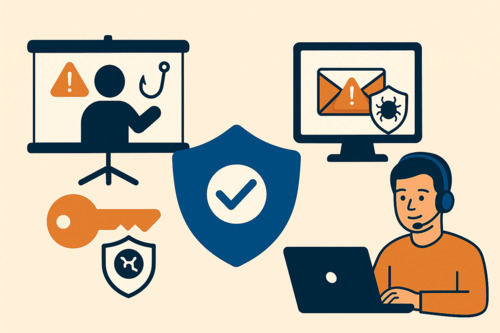
Deploying advanced email filtering and antivirus software helps detect and block potential phishing attempts and malicious attachments before they reach users. Utilizing continuous monitoring tools and fraud detection software can identify suspicious login activity or automated credential stuffing attacks in real time, allowing rapid response to potential threats. Secure credential management policies, combined with regular breach investigations and audits, are critical to minimizing the risk and impact of credential harvesting attacks on sensitive information and business operations.
Conclusion: Safeguarding Against Credential Theft
Credential harvesting poses a serious threat to both individuals and organizations, enabling attackers to gain unauthorized access to sensitive accounts and data. To protect yourself, prioritize strong, unique passwords and always enable multi-factor authentication. Organizations should invest in employee education, email security, and continuous monitoring to detect suspicious activity early.
Regularly updating systems and auditing credentials reduce vulnerabilities that threat actors exploit. By staying vigilant and implementing these proven strategies, you can significantly reduce the risk of credential theft and defend your accounts against costly data breaches and unauthorized access.
FAQ 📖
What is credential harvesting and how does it differ from other cyberattacks?
Credential harvesting is a type of cyberattack where attackers steal user credentials, such as usernames and passwords. This is often done through phishing or fake login pages to gain unauthorized access to accounts. Unlike other attacks, credential harvesting specifically focuses on collecting login information, which can serve as a gateway to more complex exploits or fraud.
What common methods do hackers use to collect login credentials?
Hackers frequently use phishing tactics, which involve fake emails or websites designed to trick users into entering their passwords. Malware, such as keyloggers, can also record keystrokes to capture credentials. Additionally, domain spoofing and man-in-the-middle attacks are used to intercept communications and steal sensitive data.
Other methods include credential stuffing, where stolen credentials are tested on multiple sites, and brute force attacks, which systematically attempt to crack passwords.
How can individuals and organizations protect themselves from credential harvesting attacks?
To protect against credential harvesting, individuals and organizations should implement multi-factor authentication (MFA) to add an extra layer of security. Regular security awareness training can help educate users on recognizing threats. Use strong, unique passwords supported by password managers to reduce risk.
Additional steps include keeping software updated, deploying email filtering and antivirus tools, using endpoint security solutions, monitoring for suspicious activities, and conducting regular audits to identify compromised credentials.
What actions should be taken if you suspect your credentials have been compromised through credential harvesting?
If you suspect someone has compromised your credentials, immediately change the passwords for all affected accounts. Enable multi-factor authentication to enhance protection.
Learn how phishing works to avoid future attacks. Use strong, unique passwords. Don’t click suspicious links or emails. Keep all your software updated to protect your system.
Found this article helpful? Explore more on email security in our in-depth guide: “What Is Business Email Compromise? How to Spot and Stop It.”
Plus, check out our blog for more practical tips and expert insights.


